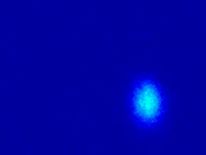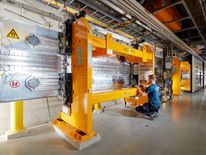The world's biggest ever X-ray laser has generated its first beam of light in a 3.4km-long underground facility beneath Hamburg.
The laser's light is a billion times brighter than the typical light sources normally used in particle accelerators.
As X-rays have a wavelength of 0.8 nanometres, almost 500 times shorter than visible light, the laser can be used to make pictures and videos of objects at an atomic level.
Scientists say it "marks the beginning a new era of research in Europe".
The laser will be used to photograph biomolecules, from which researchers hope to understand the basis of illnesses and develop new therapies.
The European XFEL project developed the laser, which is housed in a facility stretching 3.4km from the German city of Hamburg to the town of Schenefeld.
"The facility, to which many countries around the world contributed know-how and components, has passed its first big test with flying colours," said the project's managing director, Professor Robert Feidenhans'l.
"This is also a great success for scientific collaboration in Europe and across the world
"We can now begin to direct the X-ray flashes with special mirrors through the last tunnel section into the experiment hall, and then step by step start the commissioning of the experiment stations."
The powerful X-ray laser is generated from an electron beam directed through a special superconducting linear accelerator.
In a 2.1km-long section of tunnel, these electron pulses are accelerated to near-light speed before entering a photon tunnel containing a 210m stretch of X-ray generating devices.
It is here that the 17,290 permanent magnets with alternating poles, known as undulators, interact with the electron pulses, as explained in detail on XFEL's website.
These undulators are used to bring the electrons into a "slalom" course and with every change of direction the electrons release extremely short-wavelength X-ray radiation, which intensifies along the length of the undulator stretch.
Besides looking into new ways to treat illnesses, other research opportunities include observing chemical processes and improving their efficiency, or making them more environmentally friendly, as well as investigating conditions similar to the interior of planets.
Helmut Dosch, the chairman of the German particle accelerator research centre, DESY, said: "The European XFEL will provide us with the most detailed images of the molecular structure of new materials and drugs and novel live recordings of biochemical reactions."









0 comments:
Post a Comment